Sailor Suit
At one time the boy's sailor suit and the girl's sailor
dress were almost like a uniform for children. Everywhere one could
see the striped square collar. Please scroll down to learn more about
all parts of a sailor suit and some historical background. What we show
here is mostly based on German sailor suits. But the child's sailor
suit first appeared in Britain and children throughout the western world
wore similar suits.
Matrosenanzug
Der Matrosenanzug und das Matrosenkleid glichen einst
einer Uniform für Kinder. Wo man auch schaute: überall der markante
Matrosenkragen. Fall Sie mehr darüber erfahren möchten, scrollen
Sie bitte die Seite hinunter. Dort finden Sie Informationen zu den einzelnen
Teilen eines Matrosenanzuges und zu seiner Geschichte. Wir beschäftigen
uns hier hauptsächlich mit Matrosenanzügen aus Deutschland.
Allerdings tauchte der Matrosenanzug zuerst in Großbritannien
auf und ähnliche Anzüge wurden quer durch die westliche Welt
getragen.
|
Sailor suits were mostly blue, but white was also
a popular choice. Blue and white were the traditional colours.
Many other colours were also used but less commonly. Due to
the black & white photography of the day, we are a little
unsure about the colours. We have noted some red ones.
Matrosenanzüge wuren am häufigsten in
blau gearbeitet, aber auch weiß wurde oft verwendet. Das
sind die traditionellen Farben. Der Kreativität waren aber
keine Grenzen gesetzt und so wie es Variationen bei allen modischen
Merkmalen gab, war dies auch bei der Farbgebung der Anzüge
der Fall. Durch die Schwarz-Weiß-Fotographie damaliger
Zeit sind unsere Informationen hier begrenzt. Bislang habe wir
eine paar rote Matrosenanzüge entdeckt.
|
Sailor
Cap - Matrosenmütze Very often the sailor suit was worn with a cap
or hat. An especially popular and fitting choice was a sailor
cap. Another possibility was a broad-brimmed straw hat. In Germany
a peaked school cap was a popular choice. The typical sailor
cap has a saucer- or plate-like form. There were stiff and soft
versions. The styles of sailor caps varied from country to country
and were largely based on the caps worn by the sailors in each
country. An important part of the cap was the cap tally.
Sehr oft wurde zum Matrosenanzug eine Mütze
oder Hut getragen. Besonders beliebt war die Matrosenmütze,
eine andere Möglichkeit wäre z.B: ein Strohhut. Wurde
der Matrosenanzug zur Schule getragen, kam die Schülermütze
hinzu. Die typische Matrosenmütze ist eine runde Tellermütze.
Die Tellerform ist versteift, sodaß die Mütze ihre
Form nicht verliert. Es gab aber auch weichere Varianten ohne
die strenge Tellerform. Zur Mütze gehörte das Mützenband.
|
|
The cap tally is attached around the cap and forms
at the back a sort of tail called a streamer. Often there were
twin streamers almost always done in black. On the cap tally
there were often inscriptions, usually of ship names, e.g "MS
Breslau".
Das Mützenband führt rund um die Mütze
und endet in einem kürzeren oder längeren Schweif.
Das Mützenband war in der Regel mit einem Schiffsnamen
verziert, z.B. "MS Breslau".
|
Sailor
Blouse - Matrosenbluse The blouse had a V-shaped cutout at the front.
Along the cutout and round the neck the sailor collar was attached.
Usually the V-shaped neck opening in front was covered with
the dickey. The blouse had a draw string at the hem to achive
the blousing effect. The blouses were pulled over the head or
were closed with buttons at the front. There were sailor suit
versions without blousing effect as well.
Die Matrosenbluse hatte einen V-förmigen
Ausschnitt. Entlang diesen Ausschnitts und rund um den Hals
war der Matrosenkragen befestigt. Der V-Ausschnitt wurde in
der Regel durch einen Latz verschlossen. In der Taille wurde
die Bluse mit einer Zugschnur geschlossen. Es gab aber auch
Matrosenanzüge ohne Zugschnur und so auch ohne den gebauschten
Effekt. Entweder wurden die Matrosenblusen zum Ankleiden über
den Kopf gezogen oder sie hatten vorne eine Knopfleiste.
|
Sailor
Collar - Matrosenkragen The sailor collar is arguably the most recognizable
part of the sailor suit. The traditional form of the collar
is shown in figure 1 (front) and 2 (back). Traditionally the
collar is decorated with three white stripes. There have been
countless variations. Some differ so much from the traditional
collar that it makes sense to talk about sailor-style instead,
but the open V-front and the square back flap is the one constant
on most sailor blouses. Below are some examples.
Der eckige Matrosenkragen ist wohl der auffälligste
Bestandteil des Matrosenanzuges. Die traditionelle Form des
Kragens zeigt sich in den Abbildungen 1 (Vorderseite) und 2
(Rückseite). Es gab unzählige Variationen und Abwandlungen.
Traditionellerweise wurde er mit den drei bekannten Streifen
geschmückt, aber auch hier gab es zahllose Varianten. Bei
manchen Variationen mag man gar nur noch vom Matrosen-Stil sprechen,
da die Kleidung bereits sehr vom traditionellen Matrosenanzug
abweicht. Ein paar Beispiele sind unterhalb eingefügt.
|
|
The dickey is used to cover the V-shaped front
cutout. There were several versions. It seems that it was mostly
a simple piece of cloth (decorated or not) buttoned to the blouse.
There were more complicated versions, too. Sometimes, presumably
in summer times sailor suits were worn without dickeys. One
example is shown below.
Der Latz schließt den V-Ausschnitt der Matrosenbluse.
Man nannte es auch Einsatz. Es gab verschiedene Varianten. Meistens
wurde wohl einfach ein Stück Stoff in den Ausschnitt geknöpft,
aber es gab auch aufwendigere Ausführungen. Teilweise,
wohl vor allem im Sommer, wurde auch auf den Latz verzichtet.
Ein Beispiel ist unten abgebildet.
1. This dickey was pictured in a German mail-order
catalog in 1913. It was made in tricot. It was pulled over the
head and closed at the sides with ties.
2. This dickey was pictured in a German mail-order catalog in
1913. There are 3 button-holes for attaching it to the blouse.
It was offered together with fitting wristbands.
3. This dickey was offered as part of a whole sailor suit in
an Ebay auction. This American sailor suit was probably manufactured
in the 1920s. There are 2 button-holes for attaching it the
the blouse.
1. Dieser Latz war ein einem deutschen Versandhauskatalog
von 1913 abgebildet. Er wurde aus Trikot hergestellt. Er wurde
über den Kopf gezogen und an den Seiten die Bänder
geschlossen.
2. Dieser Latz war ein einem deutschen Versandhauskatalog von
1913 abgebildet. Durch die drei Knopflöcher konnte der
Latze an die Matrosenbluse geknöpft werden. Der Latz wurde
mit passenden Manschetten angeboten.
3. Dieser Latz wurde als Teil eines ganzen Matrosenanzugs bei
einer Ebay-Auktion angeboten. Dieser amerikanische Matrosenanzug
könnte aus den 1920ern stammen. Durch die zwei Knopflöcher
konnte das Latz an die Matrosenbluse geknöpft werden.
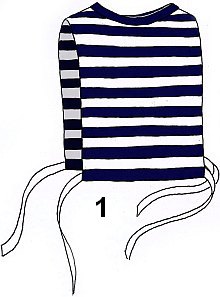 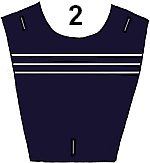 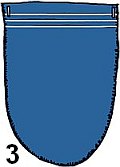
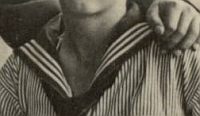
|
|
Around the collar a black scarf was worn with
an elaborate knot in the front. German sailor suits typically
had a little white ribbon to attach the scarf to the blouse.
Here we see a wide range of variations as well. Some do not
look like scarfs anymore. Some even pretend to be a complete
scarf which they are not (see picture 1).
Um den Kragen wurde ein schwarzes Tuch gebunden,
das auf der Brust kunstvoll verknotet wurde. Man nannte es Krawatte,
Schlips oder Halstuch. Typisch für den in Deutschland getragenen
Matrosenanzug war ein weißes Bändchem, mit dem das
Halstuch vorne auf der Bluse befestigt wurde. Es wurde mit einer
Schleife auf dem Knoten geschlossen. Nicht immer blieb es bei
der reinen Tuchform. Wie man in Abbildung 1 sehen kann, gab
es auch Formen, die nur vorgaben, dass das Tuch rund um den
Kragen geschlungen sei.
1. Here we see a scarf as pictured in a German
mail-order catalog in 1913.
1. Diese Halstuch-Variation wurde 1913 in eine
deutschen Versandkatalog angeboten
|
|
The traditional sailor suits includes a decoration
of three white stripes. One version of their origin is that
the three stripes represent Nelson's three great naval victories.
However, as always there are lots of variations of the decoration.
Below are some examples.
Zum traditionellen Matrosenanzug gehört
die Dekoration von drei weißen Streifen. Eine Version
über den Ursprung besagt, dass sie an die drei großen
Siege auf See von Nelson erinnern. Jedoch gibt auch bei der
Dekoration der Anzüge breit gefächerte Variationen.
Unterhalb sind ein paar Beispiele abgebildet.
|
|
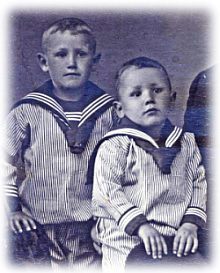 For
decades the sailor suit was the embodiment of children's fashion.
Generations of little boys ran through the streets wearing them.
Little girls subsequently began wearing the counterpart: sailor
dresses. The first wave of sailor fashion appeared before 1800,
but these suits "à la matelot" did not look like what we today
consider to be the typical sailor suit. Among other stylistic
innovations was the open neck line. It was much more comfortable
to wear than the much more elaborate fashions worn earlier.
The marine look at first was a fashion adopted by the aristocracy
and affluent middle class. The naval fashion disappeared almost
entirely, however, in the first half of the 19th century. A
new wave of enthusiasm for sailor fashions appeared in the 1860s.
Noted portratist F.X.Winterhalter in 1846 painted the 5 year
old son (future King Edward VII.) of Queen Victoria. The little
Prince was dressed for the portrait in a small sailor suit,
largely for political reasons. Winterhalter's work perfectly
captured the sweetness of the 5-year old prince. English mothers
were enamored with the image of the young prince. Noble mothers
wanted the same sweet attire for their little ones. Part of
the charm was that it was an enlisted and not an officer's uniform.
The sailor suit for the next 15 years remained confined primarily
to aristocratic circles. in the early In the early 1860s the
wider British public began adopting the sailor suit. Several
variations appeared but always recognizable because of the squared
collar. Almost at the same time the era of sailor suits also
appeared in Germany. Queen Victoria gave her German grandson
Wilhelm von Hohenzollern (the future Emperor Wilhelm II.) a
sailor suit as a present. Meanwhile photography had become very
popular and so we also have photographs of the little prince
in his sailor suit. The sailor suit in Germany, as in England,
was first adopted by aristocratic circles and later by the German
public, especially the middle class. The popular sailor suit
evolved over several decades. Girls began wearing sailor suits,
of course with skirts, in the 1880s. Even young ladies were
wearing sailor collars by 1900. The reign of Wilhelm II. (1888-1918)
was the period in which the sailor suit was most popular in
Germany. Sailor suits were, however, widely worn through Europe
from the 1880s to the 1930s. Today there a still some boy choirs
using the sailor suit as a uniform and toddlers can sometimes
be seen wearing sailor suits. For
decades the sailor suit was the embodiment of children's fashion.
Generations of little boys ran through the streets wearing them.
Little girls subsequently began wearing the counterpart: sailor
dresses. The first wave of sailor fashion appeared before 1800,
but these suits "à la matelot" did not look like what we today
consider to be the typical sailor suit. Among other stylistic
innovations was the open neck line. It was much more comfortable
to wear than the much more elaborate fashions worn earlier.
The marine look at first was a fashion adopted by the aristocracy
and affluent middle class. The naval fashion disappeared almost
entirely, however, in the first half of the 19th century. A
new wave of enthusiasm for sailor fashions appeared in the 1860s.
Noted portratist F.X.Winterhalter in 1846 painted the 5 year
old son (future King Edward VII.) of Queen Victoria. The little
Prince was dressed for the portrait in a small sailor suit,
largely for political reasons. Winterhalter's work perfectly
captured the sweetness of the 5-year old prince. English mothers
were enamored with the image of the young prince. Noble mothers
wanted the same sweet attire for their little ones. Part of
the charm was that it was an enlisted and not an officer's uniform.
The sailor suit for the next 15 years remained confined primarily
to aristocratic circles. in the early In the early 1860s the
wider British public began adopting the sailor suit. Several
variations appeared but always recognizable because of the squared
collar. Almost at the same time the era of sailor suits also
appeared in Germany. Queen Victoria gave her German grandson
Wilhelm von Hohenzollern (the future Emperor Wilhelm II.) a
sailor suit as a present. Meanwhile photography had become very
popular and so we also have photographs of the little prince
in his sailor suit. The sailor suit in Germany, as in England,
was first adopted by aristocratic circles and later by the German
public, especially the middle class. The popular sailor suit
evolved over several decades. Girls began wearing sailor suits,
of course with skirts, in the 1880s. Even young ladies were
wearing sailor collars by 1900. The reign of Wilhelm II. (1888-1918)
was the period in which the sailor suit was most popular in
Germany. Sailor suits were, however, widely worn through Europe
from the 1880s to the 1930s. Today there a still some boy choirs
using the sailor suit as a uniform and toddlers can sometimes
be seen wearing sailor suits.
Zur Geschichte der Matrosenanzüge
Lange Zeit war er der Inbegriff von Kindermode:
der Matrosenanzug. Generationen von kleinen Jungs rannten mit
ihm durch die Straßen. Kleine Mädchen trugen das Pendant: das
Matrosenkleid. Noch vor 1800 setzte die erste Marinemodewelle
ein. Doch sahen diese Anzüge "à la matelot" noch nicht so aus,
wie wir uns heute den Matrosenanzug vorstellen. Neu war unter
anderem der halsfreie Ausschnitt. Die Anzüge waren viel angenehmer
zu tragen, wie die vorher so aufwendigen Moden. Der Marinelook
blieb zunächst eine Mode des Adels, teilweise auch des reichen
Bürgertums, aber nur am Rande. In der ersten Hälfte des 19 Jh.
verschwand der Marinelook fast gänzlich, besonders im Biedermeier.
Eine neue Welle der Marinemodenbegeisterung setzte ab den 1860ern
ein. 1846 wurde der damals populäre Maler F.X.Winterhalter beauftragt,
ein Gemälde vom künftigen Prinzen von Wales (später König Edward
VII.) zu fertigen. Zu dieser Zeit war der Knabe 5 Jahre alt
und er trug für das Bild einen maßgeschneiderten Matrosenanzug.
Winterhalter schuf ein Meisterwerk an Herzigkeit und die Entzückung
über das Bild war enorm. So dauerte es nicht lange bis auch
andere kleine adlige Knaben einen Matrosenanzug bekamen. Die
folgenden fünfzehn Jahre verblieb das Kleidungsstück in den
höfischen Kreisen. Ab den 1860ern übernahm ihn nun auch das
Volk. Und gleich tauchten die unterschiedlichsten Variationen
des Anzugs auf, unverkennbar aber immer der eckige Kragen. Fast
zur gleichen Zeit begann auch die Zeit der Matrosenanzüge im
Deutschen Reich. Queen Victoria schenkte ihrem Enkel Wilhelm
von Hohenzollern (der spätere Wilhelm II.) einen Matrosenanzug.
Mittlerweile war die Photographie weit verbreitet und damit
auch das Bild vom kleinen Wilhelm im Matrosenanzug. Zunächst
verbreitete sich der Anzug wieder in den höfischen Kreisen,
um dann vom Volk übernommen zu werden. Der Siegeszug konnte
starten. Ab den 1880ern kamen dann auch die ersten Kombinationen
für die Mädchen hinzu. Um 1900 übernahmen sogar junge Damen
den Matrosenkragen. Während der Regierungszeit Wilhelms II.
hat die Matrosenkleidung wohl ihre größte Begeisterung in Deutschland
erlebt. Von 1880 bis ca. 1930 ist das Kleidungstück in ganz
Europa ein Phänomen gewesen. Heute findet sich der Matrosenanzug
noch bei einigen Knabenchören und zeigt sich zum Teil als schickes
Accessoire in der Kleinkindermode.
|
Quellenangaben / References:
Hävernick, Walter: Der Matrosenanzug der Hamburger Jungen 1890
- 1939 (Raum 352) / Walter Hävernick. - Hamburg : Hamburger
Museumsverein e.V., 1962. - (Aus den Schausammlungen ; H. 1)
Kuhn, Robert / Kreutz, Bernd: Der Matrosenanzug. Kulturgeschichte
eines Kleidungsstückes. Die bibliophilen Taschenbücher Nr. 576.
- Dortmund: Harenberg, 1989. - ISBN: 3-88379-576-3
Kaufhaus des Westens : Illustrierter Hauptkatalog 1913
/ Kaufhaus des Westens, Berlin. - Nachdr. der Ausg. Berlin 1913.
- Hildesheim ; Zürich ; New York : Olms-Presse, 2000. - ISBN
3-487-08403-1
Puppe, Fibel, Schießgewehr: Das Kind im kaiserlichen Deutschland.
Ausstellung in der Akademie der Künste vom 5. Dezember 1976
bis zum 30. Januar 1977. - Berlin : Abakon Verlagsgesellschaft,
1977. - ISBN: 3-8200-0113-1
Weber-Kellermann, Ingeborg: Die Kindheit: eine Kulturgeschichte.
- Frankfurt a.M : Insel Verlag, 1989. - ISBN: 3-458-09778-3
Warenhaus A. Wertheim : Mode-Katalog / Warenhaus A.
Wertheim Berlin : 1903, 1904. - Hildesheim, New York : Olms,
2000
http://www.histclo.com
|
|
